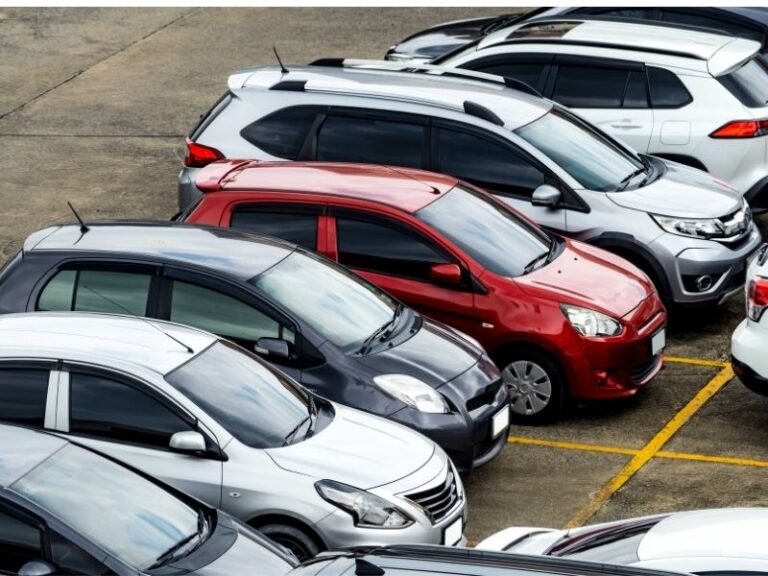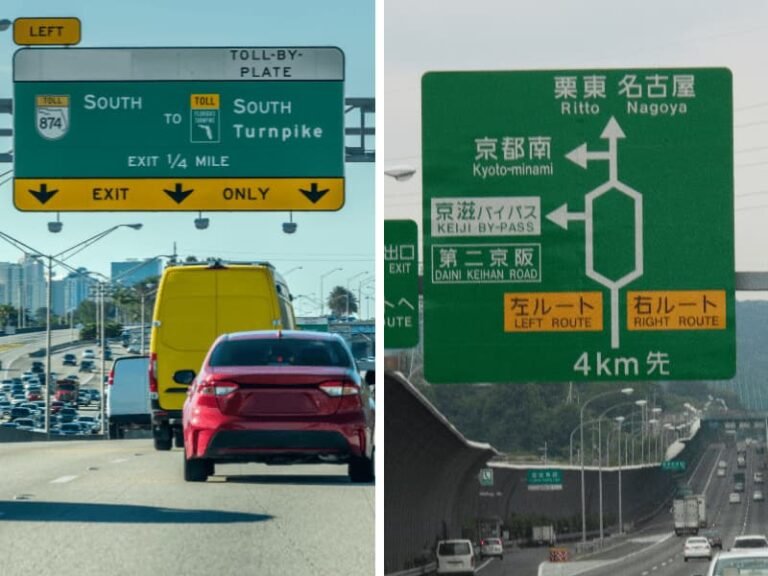Tokyo vs New York Culture Shocks – A Japanese Traveler’s Perspective
First Impressions: The Energy of Tokyo vs New York
When I first arrived in New York City, I was overwhelmed—in a good way. The energy was intense, fast-paced, and full of life. One of the first things I noticed was the incredible diversity. People of all races, cultures, and backgrounds blended together in a way I had never seen before. It felt like the whole world was squeezed into one city block.
Another big surprise? The noise. Car horns echoed through the streets, music poured out from subway performers, and conversations buzzed on every corner. Tokyo can be loud too—especially around Shibuya or Shinjuku—but the sound in NYC felt wilder, more chaotic. In Tokyo, there’s a sense of controlled noise. In New York, it’s full-volume all the time.
I also had a bit of a misconception: I thought New York City was just Manhattan. But I soon learned that NYC actually has five boroughs: Manhattan, Brooklyn, Queens, The Bronx, and Staten Island. Each one has its own character and style. Most first-time visitors spend their time in Manhattan, like I did, but there’s so much more to explore beyond it.
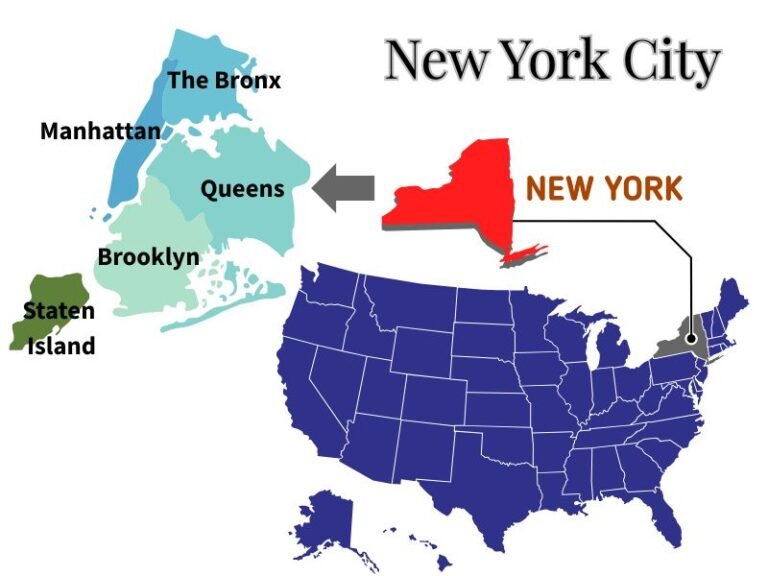
Another cultural contrast that stood out to me was fashion. I had imagined New Yorkers to be super fashionable—and they are—but in a different way than Tokyoites. In New York, people wear whatever they want: bold prints, vintage jackets, quirky accessories… and no one seems to care what anyone else thinks. There’s a sense of freedom and individuality. In Tokyo, fashion tends to be more polished and trend-conscious. People often aim to match the season or current styles, and bold personal statements are a bit less common.
But there’s one fun thing both cities have in common: fast walkers! Whether you’re in Shinjuku Station or dashing through Times Square, people move with purpose. If you stand still too long, you’ll get swept away!
Transportation & City Layout : Tokyo vs New York
I’ve traveled to many countries, but Tokyo’s public transportation still amazes me. It’s fast, punctual, and clean. Whether you’re taking a local train, hopping on the metro, or catching the Shinkansen bullet train, everything runs like clockwork. The stations are spotless, the signage is clear (often in English, too!), and even during the rush hour crush, people line up and behave politely.
When I arrived in New York, I found the subway incredibly convenient—but it definitely had a different vibe. The trains run 24/7, which is impressive, but the cars felt older, and the platforms weren’t always the cleanest. Sometimes I encountered uncomfortable moments—like people asking for money, performing, or playing music loudly from their phones. Still, it worked! You can get just about anywhere in the city by subway, and that’s something I really appreciated.
Metro & Train Systems: Tokyo vs New York
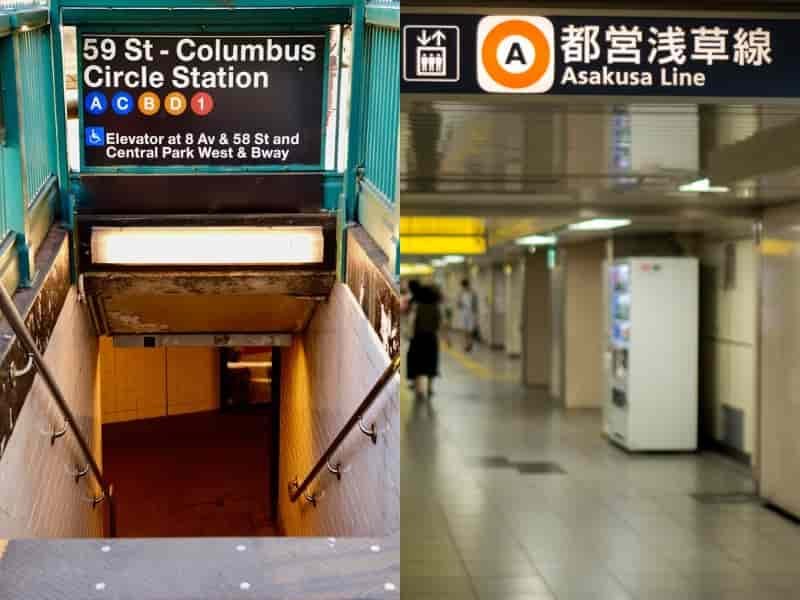
Tokyo has multiple train companies, but the biggest ones are JR (Japan Railways) and Tokyo Metro. Together, they form an intricate network that covers not only Tokyo but much of the surrounding area. Everything is hyper-efficient, and trains arrive to the minute. Plus, the Shinkansen can take you from Tokyo to Osaka in about 2.5 hours—a dream for long-distance travelers.
In contrast, the New York City Subway is run by the MTA and mainly serves the five boroughs. For long-distance travel in the U.S., you’d take Amtrak, which connects major cities across states. Compared to JR or the Shinkansen, Amtrak is slower, more expensive, and less punctual—but it offers a scenic way to see the countryside, and you don’t have to deal with airport lines.
I once took an Amtrak train from Philadelphia to New York, and something unexpected happened—the train suddenly stopped and the conductor announced, “This train is out of service. Please get off.” That was it! No further explanation.
We were confused and unsure what to do next. At first, I thought maybe we were the only ones who didn’t understand, but even local American passengers were puzzled. People started talking to each other, exchanging bits of information. We eventually figured things out and boarded another train, and it actually became a funny, memorable moment. Everyone—strangers—helped one another and laughed about the situation.
If this kind of thing had happened in Japan, I think the mood would’ve been much more serious. People might have gotten frustrated or even angry. But in that moment on Amtrak, the confusion turned into a small adventure.
Want to dive deeper? I wrote a full guide comparing the subway systems in both cities—check out Tokyo Subway vs NYC Subway: My Honest Experience for tips, surprises, and cultural insights.
Buses and Ferries : Tokyo vs New York

Both cities have bus systems, but I found Tokyo’s buses a bit tricky at first. The routes can be complicated, and they often don’t use Roman letters on the signs outside the bus. However, every stop is announced clearly inside the bus, usually in Japanese and sometimes in English too. So even if the route looks confusing at first, you can always tell where to get off—which is very reassuring.
In New York, the city buses were easier for me to figure out thanks to Google Maps and visible bus numbers. They’re slower than the subway, but a good option when you’re not in a rush—or if it’s raining!
One thing I didn’t expect in New York was the ferry system. NYC Ferry offers a relaxing and affordable way to travel between boroughs, especially from Manhattan to Brooklyn or Queens. I even got skyline views for the price of a subway ride! Tokyo has ferries too—like the Tokyo Water Bus—but they’re more of a scenic experience rather than a daily transportation method.
Food & Dining Experience: Eating Out in Tokyo vs New York
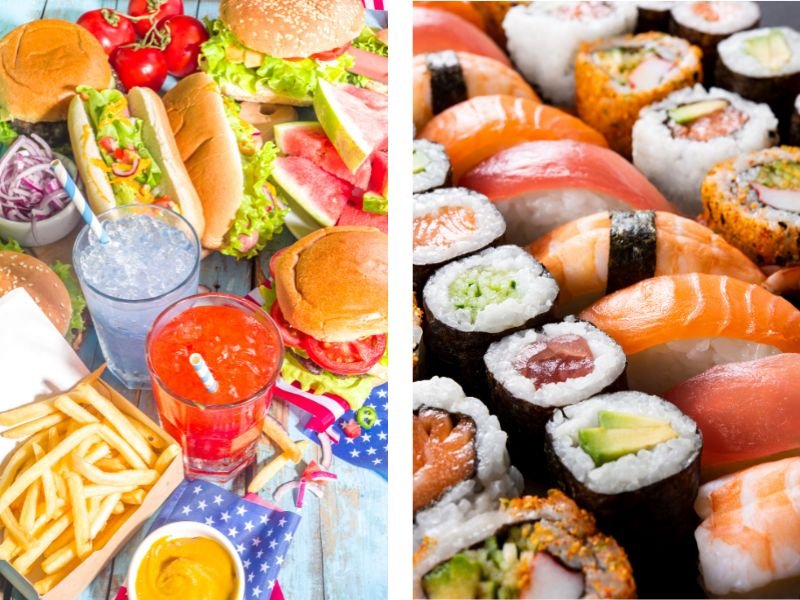
Food is always a highlight when traveling, and both New York City and Tokyo are food lovers’ paradises—but in very different ways.
In New York, I was amazed by the variety of international cuisines: from Italian to Ethiopian, Jewish delis to Dominican food trucks—you can travel the world without ever leaving the city. Tokyo also offers global options, but I honestly feel like Tokyo has even more variety when it comes to both Japanese and international food, and you can enjoy it at a much more reasonable price.
One big difference? Dining in New York is expensive. Even casual meals at restaurants or cafes can quickly add up, especially after taxes and tips. In Tokyo, on the other hand, you can eat incredibly well on a budget. From ¥500(about 3.5-4 USD) beef bowl (Gyudon) shops to standing sushi bars, there’s an endless range of affordable, delicious, and high-quality meals—and you never have to tip. That casual, no-pressure dining style made eating out in Tokyo much easier and more relaxing.
In New York, tipping is expected—usually 18–20%—and while service is often friendly, it adds to the total cost. In Tokyo, service is typically polite, efficient, and built into the culture without any expectation of tipping. This contrast gave me a deeper appreciation for the dining etiquette I grew up with in Japan.
Of course, it was fun to see how Japanese food is embraced in NYC. I spotted ramen shops, sushi bars, and even teppanyaki grills in several neighborhoods. It reminded me how much Japanese cuisine has become a part of global food culture. My former boss in Japan used to travel to NYC for business and always made it a tradition to eat at his favorite ramen shop there—it became one of his personal rituals.
In the end, both cities celebrate food in their own way. New York is bold, diverse, and exciting—but comes at a cost. Tokyo is equally rich in variety, but offers more affordability and casual comfort, especially for everyday meals.
Mini Food Guide: What to Try in Tokyo & New York
Must-Try in New York City

- New York-style pizza – Grab a slice from a corner pizzeria (cheap and iconic!)
- Bagels with lox & cream cheese – A classic NYC breakfast
- Halal street food – Look for the famous white sauce and spicy red sauce
- Pastrami sandwich – Try Katz’s Delicatessen for an unforgettable bite
- Japanese ramen – Yes, even in NYC! I recommend finding a local favorite shop
Must-Try in Tokyo
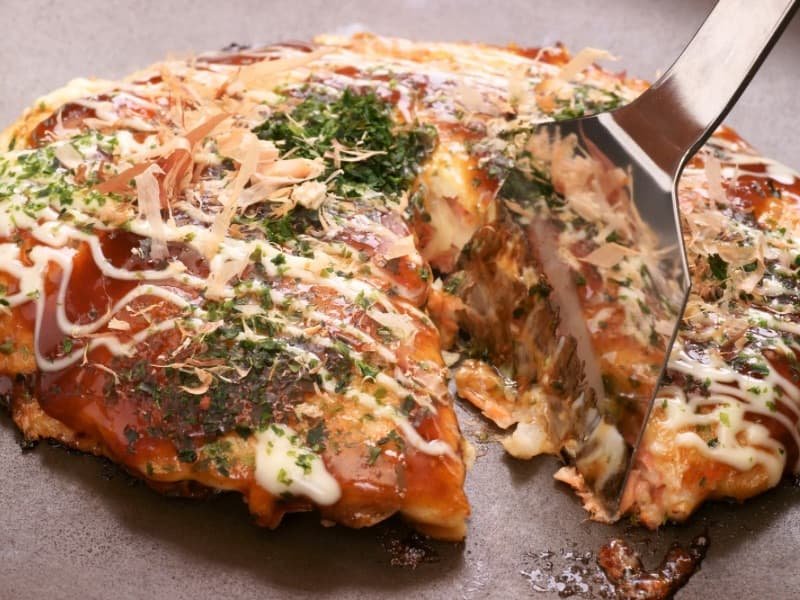
- Tonkotsu or shoyu ramen – Affordable, satisfying, and found everywhere
- Conveyor belt sushi (kaitenzushi (回転寿司)) – Fun, fast, and great quality for the price
- Okonomiyaki – Savory Japanese pancake, especially popular in casual eateries
- Bento lunch boxes – Pick one up at a train station for a perfect on-the-go meal
- Convenience store snacks (konbini) – Surprisingly delicious and budget-friendly!
Tip
In Tokyo, don’t forget to try local specialties by region—even in the city you can find regional ramen styles, seafood, and seasonal treats. Click here to “Japanese Food Culture: The Complete Region-by-Region Guide”
Culture & Daily Life: Tokyo vs New York

Life in Tokyo and New York moves quickly, but the cultural atmosphere is surprisingly different.
In Tokyo, there’s an unspoken sense of social harmony. People speak quietly in public, avoid phone calls on the train, and follow rules without needing reminders. Whether it’s lining up at the station or keeping spaces clean, there’s a strong group awareness—everyone is mindful of how their actions affect others. This makes the city feel calm and orderly, even when it’s crowded.
New York, on the other hand, felt lively and expressive. People speak more freely, often at a higher volume, and it’s completely normal to see strangers talking on the street or even dancing in the subway. I remember being surprised (in a good way) by how often people would smile, compliment my bag, or ask where I was from. That kind of casual interaction is rare in Japan, especially with strangers.
After living in the U.S. for a few years now, I’ve come to really enjoy this openness. Even though my English isn’t perfect, small conversations with people I don’t know—at the grocery store, on the bus, or while waiting in line—sometimes lift my spirits in unexpected ways. These spontaneous moments make daily life feel more connected, and they’ve even given me more confidence in expressing myself.
In Japan, it’s more common to keep to yourself in public. It’s not cold—just reserved. So while Tokyo feels smooth and predictable, New York gives off a kind of vibrant unpredictability. One city values harmony, the other celebrates individuality.
Compare Cultural Norms: Tokyo vs New York
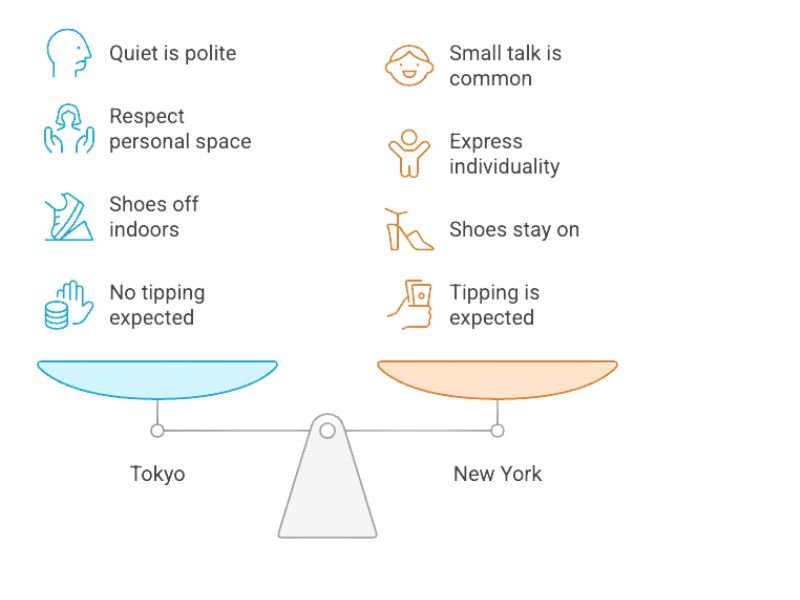
Tokyo (Japan)
- Quiet is polite – Avoid talking on phones in trains and speak softly in public.
- Stand in line – Whether it’s an elevator or a train platform, lining up is expected.
- No public trash cans – Carry your trash with you; cleanliness is a shared responsibility.
- Shoes off indoors – Be prepared to remove shoes in homes, some restaurants, and fitting rooms.
- Respect personal space – Physical touch and direct eye contact are often minimal.
New York (USA)
- Small talk is common – It’s normal to chat with strangers, even briefly, in everyday situations.
- Louder atmosphere – Trains, restaurants, and public spaces are often full of lively conversation.
- Tipping is expected – Tip 15–20% at restaurants, and don’t forget hotel or taxi tips.
- Express individuality – People freely dress, speak, and act how they like—uniqueness is celebrated.
- Shoes stay on – You’ll usually keep your shoes on indoors unless it’s a private home that requests otherwise.
Tip
Neither way is right or wrong—just different! Being aware of local customs shows respect and helps you connect with the culture more deeply.
Times Square vs Shibuya: The Crossroads of Energy
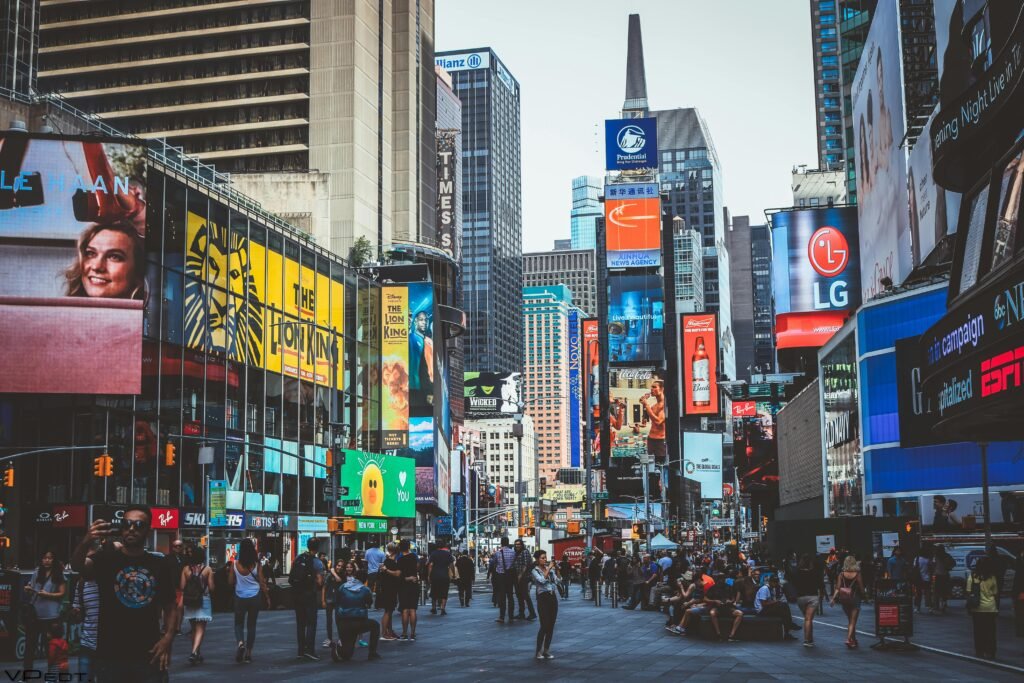
If New York has Times Square, Tokyo has Shibuya Crossing—and both are must-see spots full of lights, energy, and people.
Times Square felt like a never-ending explosion of movement and color. Giant billboards, flashing lights, street performers, taxis honking—it’s exciting, but also overwhelming. It felt very touristy to me, with lots of souvenir shops and crowds standing still to take photos. I enjoyed visiting, but I probably wouldn’t go often if I lived in NYC.
Shibuya Crossing, by contrast, felt more like an everyday moment turned iconic. You’ll see hundreds of people crossing from all directions, but it’s smooth, organized, and somehow peaceful despite the chaos. Shibuya is also surrounded by shopping, cafés, and nightlife—but it’s less about being flashy and more about style and flow.
I think of Times Square as theatrical, while Shibuya feels cinematic. One says “look at me!” while the other says “you’re part of this moment.” Both are unforgettable, but in very different ways.
Crime Rate & Safety: Tokyo vs New York

One of the most common questions travelers ask is: “Which city is safer—Tokyo or New York?” Based on statistics and personal experience, the answer is pretty clear.
Tokyo is consistently ranked as one of the safest major cities in the world. Crime rates—especially violent crime—are extremely low. It’s not unusual to see children riding the train alone, people leaving their wallets on the table while they get coffee, or lost items being turned in and returned. Of course, no city is perfect, but the sense of safety in Tokyo is something I truly appreciate.
New York City has come a long way since its more dangerous reputation in the past. Today, it’s much safer than people might think—especially in tourist areas like Midtown Manhattan, the Upper West Side, or Brooklyn’s main neighborhoods. That said, petty crimes like pickpocketing or subway theft do happen more often than in Tokyo. It’s important to stay alert, especially at night or in less busy areas.
What surprised me most was that in Tokyo, people rarely worry about personal safety in daily life, even late at night. In New York, I learned to be more cautious—checking my surroundings, keeping my bag close, and avoiding empty subway cars.
Tip
Tokyo may feel safer overall, but both cities are very walkable and exciting—as long as you stay aware and travel smart.
Must-Visit Spots of New York from a Japanese Traveler’s Perspective
During my trip, I visited several famous landmarks that made my NYC experience unforgettable. Each destination had its own charm, and some even reminded me of places in Tokyo in unexpected ways.
Statue of Liberty
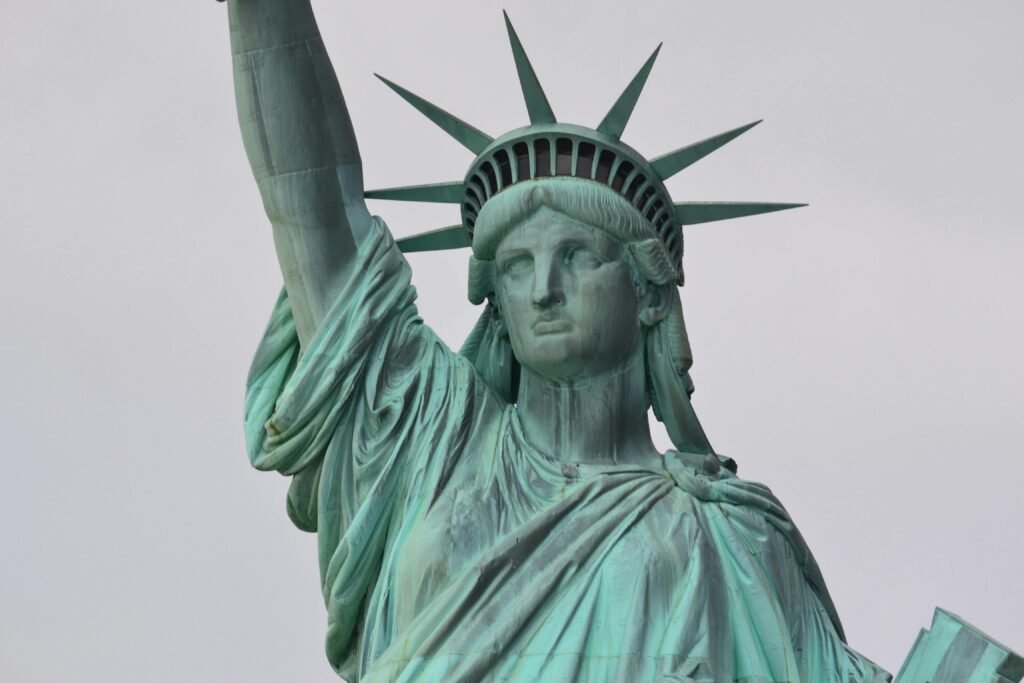
Seeing the Statue of Liberty up close was surreal. As a symbol of freedom and history, it felt like a true “I’m in New York!!” moment. The ferry ride was also enjoyable, giving great views of the city skyline.
For the details, please visit National park official HP
Empire State Building
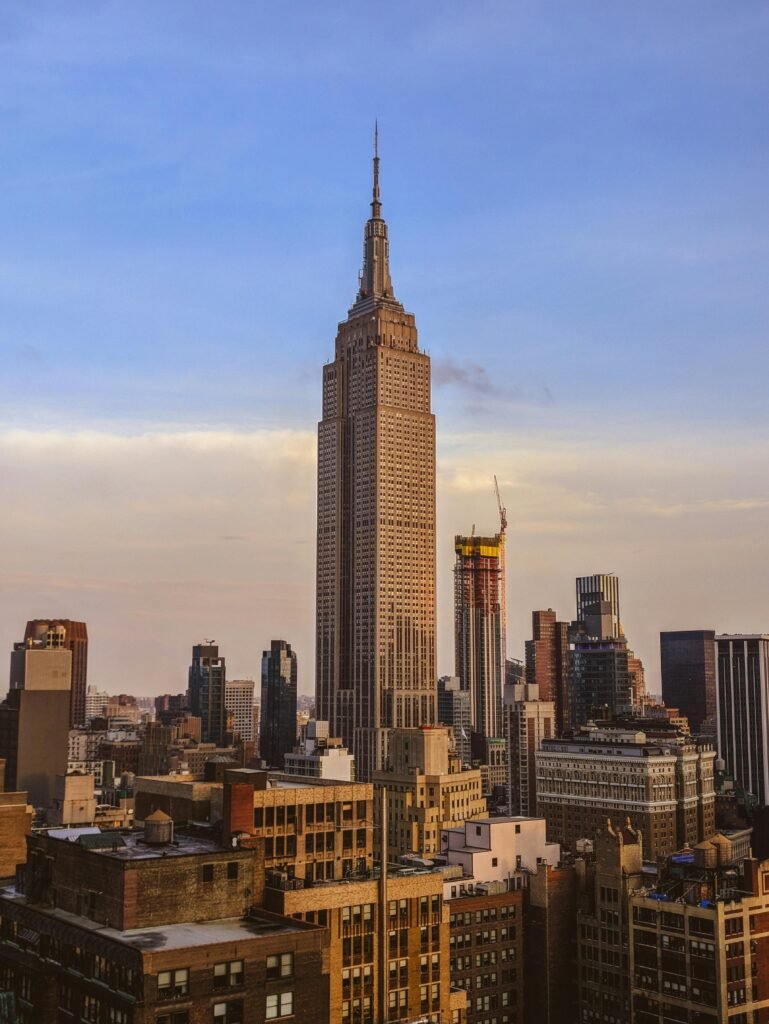
Tokyo has its own impressive skyscrapers, but standing at the top of the Empire State Building and looking out over NYC was a breathtaking experience. However, if you have acrophobia, the observation floor might feel terrifying—unlike many observation decks in Japan, there’s no protective glass wall, and you can feel the wind directly at such a high altitude. I was extremely scared, but at the same time, it made the view feel even more dramatic and thrilling.
For the details, please visit Empire State Building official HP.
Central Park
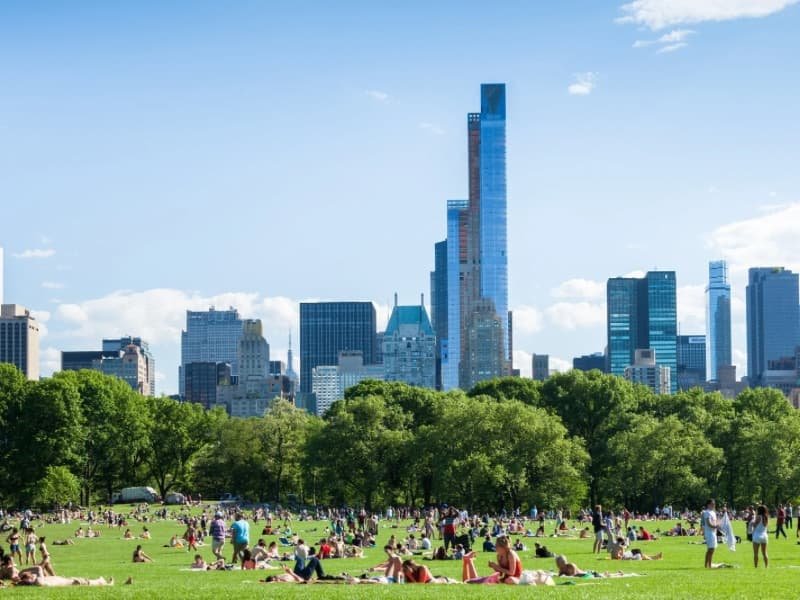
A beautiful oasis in the middle of the city, much like Shinjuku Gyoen in Tokyo but on a much grander scale. I loved the mix of nature and urban life, whether it was people jogging, relaxing on the grass, or even spotting street performers. I really like this place.
For the details, please check the Central Park official HP.
Times Square

The lights, the billboards, the constant motion—it had the same electric energy as Shibuya Crossing, but multiplied by ten. It felt like stepping into a larger-than-life version of Tokyo’s neon-filled districts, making it one of the most memorable spots of my trip.
For the details, please check the Times Square Official HP.
American Museum of Natural History
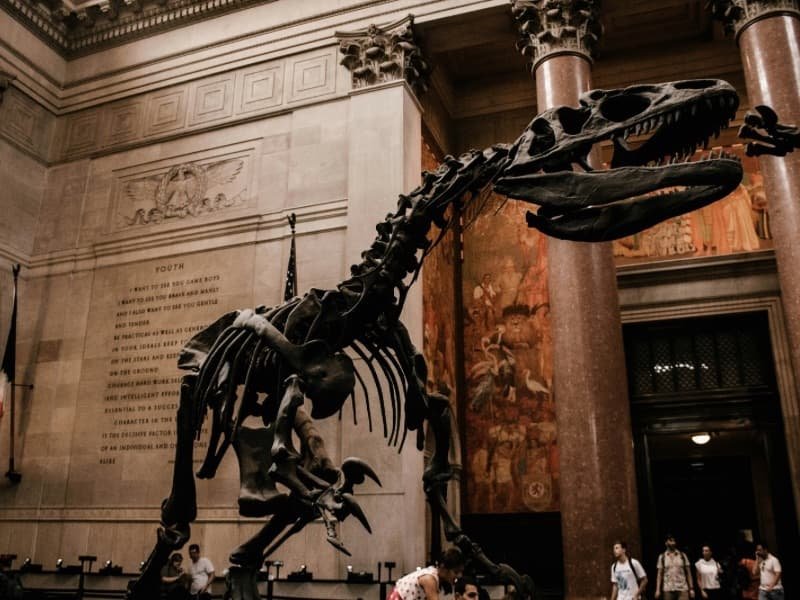
I wanted to visit this museum because I love the movie Night at the Museum! Walking through the exhibits, I kept imagining scenes from the film. The museum was vast, filled with fascinating artifacts, and definitely worth a visit for any movie fan or history lover.
For the details, please check the American Museum of National History Official HP.
Brooklyn Bridge

Walking across the Brooklyn Bridge at sunset was stunning. It had a nostalgic charm, reminding me of scenic walking spots in Japan, but with a distinctly New York feel.
For the details, please visit Brooklyn Bridge Park official HP.
Grand Central Terminal
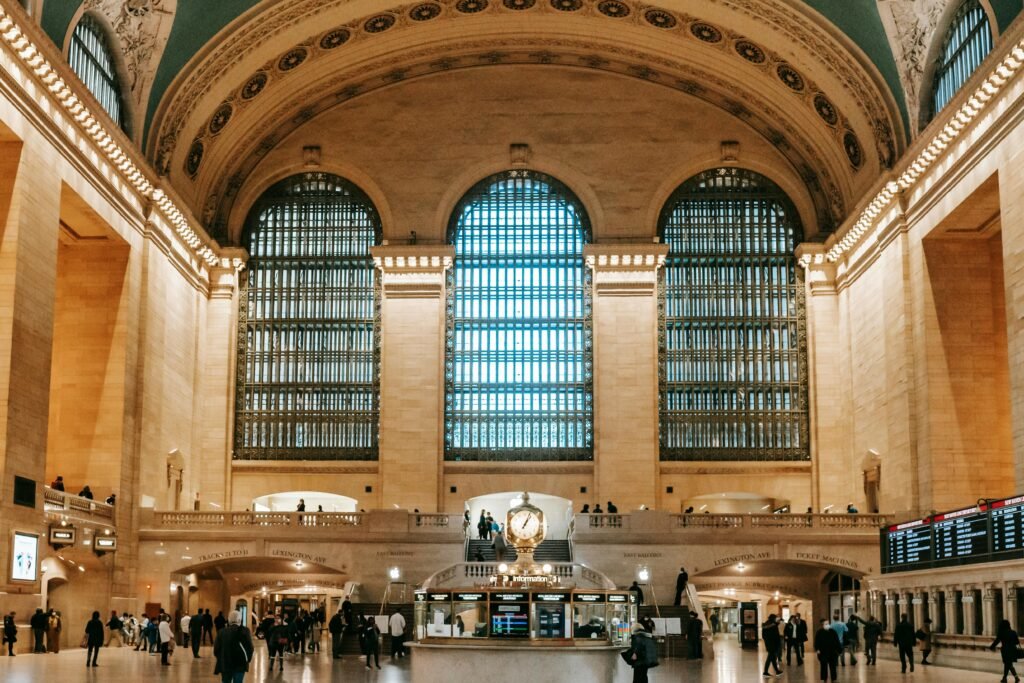
I stayed at a hotel near this station, so I used this station many times to go to many attractive places in NYC. A transportation hub unlike any in Japan, Grand Central Terminal felt grand and historical, almost like something out of a movie. The architecture was stunning, and I loved watching the movement of people bustling through it.
Walking across the Brooklyn Bridge at sunset was stunning. It had a nostalgic charm, reminding me of scenic walking spots in Japan, but with a distinctly New York feel.
For the details, please visit the Brooklyn Bridge Park official HP.
I stayed a hotel near this station, so I used this station many times to go to many attractive place in NYC. A transportation hub unlike any in Japan, Grand Central Terminal felt grand and historical, almost like something out of a movie. The architecture was stunning, and I loved watching the movement of people bustling through it.
For the details, please visit Grand Central Terminal official HP.
Each of these places added something unique to my experience in New York, making the trip unforgettable.
Tokyo vs New York: Quick Comparison Table
| Category | Tokyo | New York City |
|---|---|---|
| Transportation | Clean, punctual trains (JR, Metro), buses with stop announcements, no tipping | Older subway system, useful but less clean; buses and ferries; tipping common |
| Train Experience | Organized and polite, even during rush hour | More chaotic; sometimes unpredictable; Amtrak experience can vary |
| Food & Dining | Affordable, wide variety, no tipping required | Expensive dining, tipping expected, great global variety |
| Dining Atmospher | Quiet, respectful, efficient servic | Lively, friendly, casual but more costly |
| Fashion & Style | Sleek, coordinated, trend-focus | Free-spirited, unique, individualistic |
| Social Etiquette | Quiet in public, minimal small talk, group harmony | Outgoing, expressive, open to conversations |
| Iconic Area | Shibuya Crossing – fast-paced but orderly | Times Square – flashy, crowded, tourist-heavy |
| Safety / Crime Rate | Very low; high trust and order | Improved, but still more petty crime than Tokyo |
| Cultural Vibe | Polite, structured, reserved | Energetic, spontaneous, diverse |
Frequently Asked Questions: Tokyo vs New York
Q1. Which city is safer, Tokyo or New York?
Tokyo is generally considered safer than New York, especially in terms of street crime. In Japan, it’s common to see people leave bags unattended in cafes or children traveling alone on trains. New York is safe in many areas, but like any major US city, it’s wise to be more cautious, especially at night.
Q2. Is public transportation better in Tokyo or New York?
Tokyo’s trains are famous for punctuality, cleanliness, and extensive coverage, making them one of the most reliable systems in the world. New York’s subway runs 24/7, which Tokyo’s does not, but it can be less clean and sometimes less reliable.
Q3. Which city is more expensive to visit?
Both cities can be expensive, but costs vary depending on your choices. Accommodation in Tokyo can be more affordable than in Manhattan, but dining and transportation are often cheaper in Tokyo. In New York, museum and entertainment costs can be higher.
Q4. How do tipping cultures differ between Tokyo and New York?
In Tokyo, tipping is not expected and can even be considered rude — good service is included in the price. In New York, tipping is part of the culture, with 15–20% expected at restaurants, taxis, and for many services.
Q5. Which city is better for food lovers?
Tokyo offers a huge range of high-quality food at all price points, from Michelin-starred sushi to budget ramen shops. New York also has an incredible food scene, with diverse international cuisines, but dining out can be more expensive.
Q6. Why are Tokyo’s streets so much cleaner than New York’s?
Tokyo’s exceptional cleanliness often surprises first-time visitors—despite being a bustling megacity, you’ll rarely spot trash on the ground. This stems from Japan’s organized waste practices, cultural norms around personal responsibility (people carry their trash until they find a bin), and strong social etiquette around cleanliness.
Learn more -> Navigating Japan’s Recycling System: Tips for Visitors and Long-Term Residents
Q7. How crowded does Tokyo feel compared to New York?
Tokyo can technically be more densely populated, but it rarely feels claustrophobic. Local orderliness—from efficient lining to seamless crowd flow—makes it feel more spacious and calm than New York’s sometimes chaotic bustle.
Q8. Is Tokyo more affordable to visit than New York right now?
As of 2024, Tokyo has become noticeably more budget-friendly than New York. Lower hotel rates, cheaper meals (even at Michelin-starred restaurants), and many free or low-cost attractions make Tokyo a comparatively great value destination. Seeing from a Japanese point of view, the price in Japan has been getting higher recently, even though it is still lower than in NYC.
Q9. What cultural differences do travelers notice in etiquette?
After traveling to many countries, I’ve come to appreciate just how unique Japanese culture is—especially when it comes to etiquette. In Tokyo, people tend to be quiet in public spaces, form orderly lines when boarding trains or buses, and follow customs like bowing to show respect. These behaviors create a sense of calm and consideration in everyday life.
In contrast, New York City has a much more casual and expressive vibe. It’s common to hear lively conversations in public, and people often speak to strangers with ease and spontaneity. The energy feels more open and direct, which can be refreshing—but also surprising if you’re used to Tokyo’s quieter norms.
Interesting Japanese etiquette? visit my page ->Useful Japanese Etiquette for Tourists: Essential Tips Before You Visit
Final Thoughts: A Japanese Traveler’s View of Two Iconic Cities
Experiencing both Tokyo and New York has helped me appreciate how uniquely vibrant each city is—Tokyo with its structured calm and quiet etiquette, and New York with its expressive energy and cultural diversity. They move at a similar fast pace, but the feeling on the streets, in restaurants, and in daily life is completely different.
I didn’t write this post to say one city is better than the other—but to share how it feels to walk through each from a Japanese perspective. Whether you love organized harmony or spontaneous connections, both cities offer something unforgettable.
Have you ever visited both Tokyo and New York?
What stood out to you the most? I’d love to hear your thoughts or questions in the comments!
